Ruby Necklace Succulent Plant (Othonna capensis) Profile
Written by Iris
Dec 03 2022
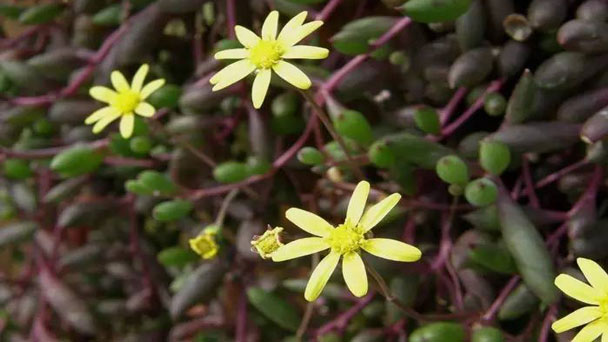
Ruby Necklace Plant, also known as Othonna capensis, is a distinct species from South Africa. This trailing Ruby Necklace Plant features long purple stems of green bead-like fleshy leaves. Ruby Necklace Plant will bloom in spring with beautiful daisy-like yellow flowers. A must for a hanging pot or wall, Ruby Necklace Plant is a great indoor and outdoor plant.
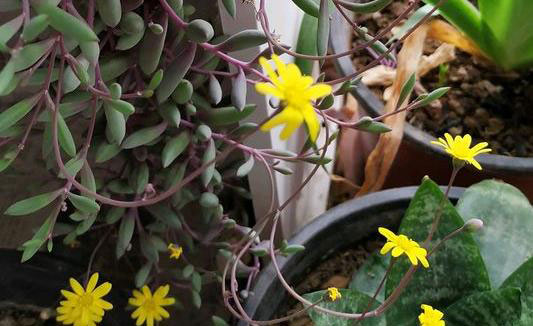
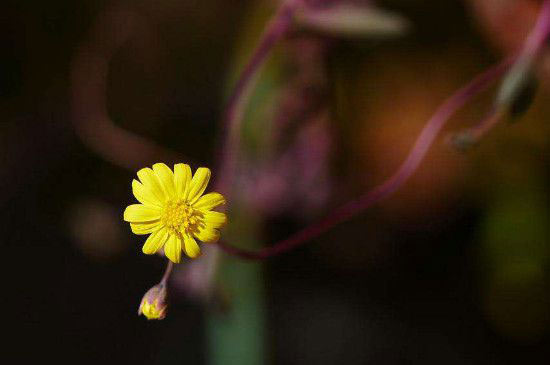
Seed pods are located at the tips of completely dried flowers and should be removed carefully.
Sterilize dry soil in the microwave for 90 seconds. This will kill harmful bacteria.
Dry the succulent seeds of the Ruby Necklace Plant and plant them under the top layer of the soil.
Place in indirect sunlight or growth light. Cover the soil with a plastic or glass lid to retain moisture.
After a month, it will grow young saplings that can be transferred to a larger pot.
Just cut with a clean, sterilized cutting tool and let it harden for an hour or two.
Use rooting hormone when potting in soil.
During reproduction through the stem, fragile leaves may be shed from the stem.
However, if you find broken healthy leaves with small stems, throw them into the same pot.
When the Ruby Necklace Succulent Plant has long branching stems, you might notice that aerial rooting occurs after some intervals in the stems. From then on, do a clean cut on the Ruby Necklace Plant 1 inch below the root using a clean sterilized cutting tool, and wait for the callus for 1 to 2 hours before potting it into damp soil. Put it in indirect bright sunlight.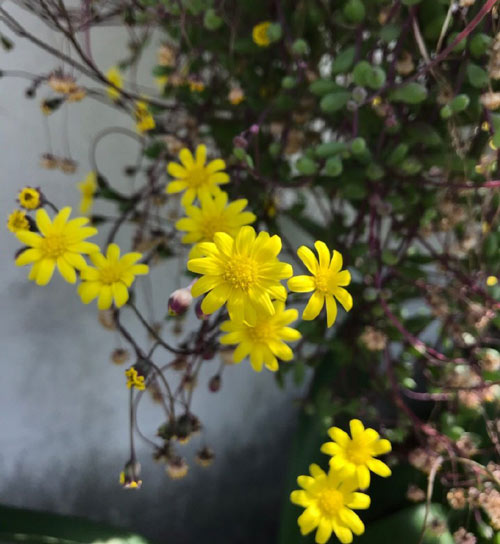
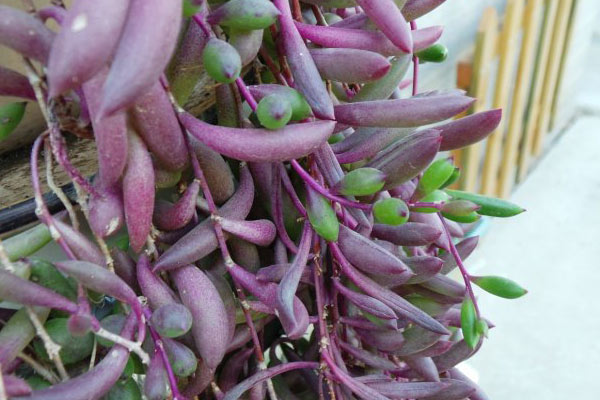
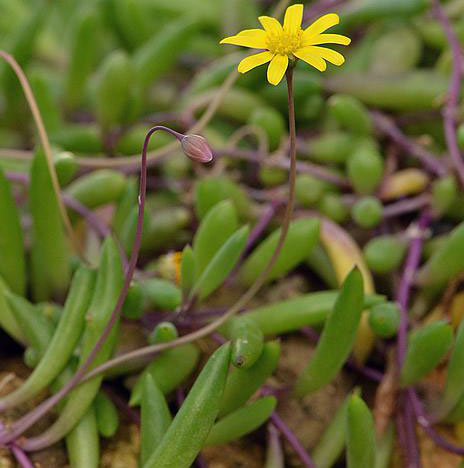
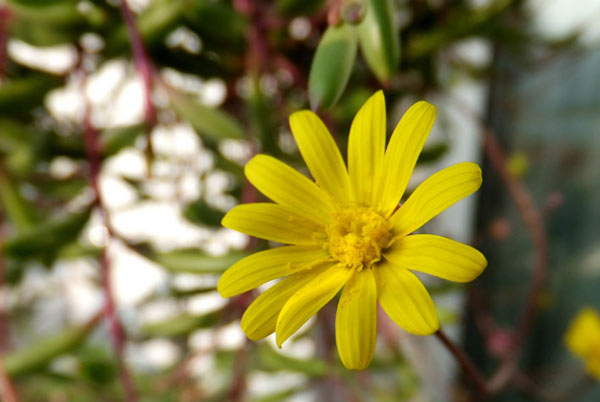
Second: Why the Ruby Necklace Plant Succulent is good for planting on the balcony is because it only takes up less space to grow and a little light. Then the balcony is very suitable as the place. Besides being good on the balcony, it is also good for planting on the terrace because of its excellent growth properties when planted hanging in a basket.
Ruby Necklace Succulent Plant PictureRuby Necklace Succulent Plant InfoRuby Necklace Succulent Plant Ecological HabitsRuby Necklace Succulent Plant DistributionHow to Grow and Care for Ruby Necklace Succulent PlantHow to Grow Ruby Necklace Succulent PlantHow to Care for Ruby Necklace Succulent PlantUses of Ruby Necklace Succulent PlantRuby Necklace Succulent Plant Common Pests/DiseasesRuby Necklace Succulent Plant Design TipsBalcony/Patio PlantPotted SpecimenHanging BasketRuby Necklace Succulent Plant Companion Plants
Ruby Necklace Succulent Plant Picture

Ruby Necklace Succulent Plant Info
| Botanical Name | Othonna capensis |
| Common Name | String of rubies, Ruby Necklace Plant, string of pickles, Ruby Necklace Succulent |
| Plant Type | Succulent |
| Mature Size | 2 inches tall |
| Sun Exposure | Direct sun |
| Soil Type | Well-draining, cactus/succulent soil |
| Soil pH | 6.0-6.5 |
| Bloom Time | Spring, summer, fall |
Ruby Necklace Succulent Plant Ecological Habits
Ruby Necklace Plant (Othonna Capensis) is a charming purple flushing perennial succulent in the Compositae family. Often called the little pickles ruby necklace Plant, it is a popular houseplant. The Ruby Necklace Plant, native to South Africa, is adapted to arid, rocky environments and uses underground storage organs to survive, allowing them to grow without soil. The ruby necklace succulent Plant requires less frequent watering and some bright sunlight. The Ruby necklace succulent Plant forms a charming trailing stem with succulent oval leaves that are dark green with a lovely purple flush. Plants will develop a more intense purple color under more light. But be careful, as even succulents will burn, allowing the plants to gradually adapt to strong sunlight. The flowers are small and yellow, similar to daisies, and they contrast beautifully with the purple leaves.Ruby Necklace Succulent Plant Distribution
This species is is endemic to the Eastern Cape Province in semi-arid Karoo scrub and dry, rocky flats, often in the partial protection of surrounding vegetation or rocks.
How to Grow and Care for Ruby Necklace Succulent Plant
How to Grow Ruby Necklace Succulent Plant
- With Seeds
Seed pods are located at the tips of completely dried flowers and should be removed carefully.
Sterilize dry soil in the microwave for 90 seconds. This will kill harmful bacteria.
Dry the succulent seeds of the Ruby Necklace Plant and plant them under the top layer of the soil.
Place in indirect sunlight or growth light. Cover the soil with a plastic or glass lid to retain moisture.
After a month, it will grow young saplings that can be transferred to a larger pot.
- With Cuttings
Just cut with a clean, sterilized cutting tool and let it harden for an hour or two.
Use rooting hormone when potting in soil.
During reproduction through the stem, fragile leaves may be shed from the stem.
- With Leaves
However, if you find broken healthy leaves with small stems, throw them into the same pot.
- With Division
When the Ruby Necklace Succulent Plant has long branching stems, you might notice that aerial rooting occurs after some intervals in the stems. From then on, do a clean cut on the Ruby Necklace Plant 1 inch below the root using a clean sterilized cutting tool, and wait for the callus for 1 to 2 hours before potting it into damp soil. Put it in indirect bright sunlight.

How to Care for Ruby Necklace Succulent Plant
- Light
- Soil
- Water
- Temperature and Humidity
- Fertilizer
- Pests and Diseases

Uses of Ruby Necklace Succulent Plant
Depending on your setting, othonna can be an extremely versatile plant. Some of its uses include:- In containers or hanging baskets planted as a trailing succulent
- Stabilizing banks
- Coastal gardens in full sun
- Border planting
- Retaining walls
- Ground cover
- Interplanting
- Rock gardens
- Wild gardens
- Edging
- Filler

Ruby Necklace Succulent Plant Common Pests/Diseases
Watch out for common sap-sucking houseplant pests such as mealybugs and scale on your string of rubies. Regularly inspecting the Ruby Necklace succulent and catching any pests early is the best way to prevent more serious infestations. Treat affected plants with rubbing alcohol, neem oil, or insecticidal soap to get rid of unwanted pests.
Ruby Necklace Succulent Plant Design Tips
Balcony/Patio Plant
Ruby Necklace Plant Succulent is a plant that usually adorns balconies in luxury homes. It is not a cheap ornamental plant, but an expensive plant in terms of interest and makes many people like it. There are several reasons why Ruby Necklace Plant is suitable for planting on the balcony. First: Ruby Necklace Plant only requires a little water so it doesn't cause your balcony to get dirty with running water. So, he can survive well without any special attention. Even if it is watered excessively it can cause the roots to rot and eventually die.Second: Why the Ruby Necklace Plant Succulent is good for planting on the balcony is because it only takes up less space to grow and a little light. Then the balcony is very suitable as the place. Besides being good on the balcony, it is also good for planting on the terrace because of its excellent growth properties when planted hanging in a basket.
Potted Specimen
Ruby Necklace Plant is a succulent plant that is good in specimen planting. It doesn’t need a lot of water and is good for growing in pots. even during the experiment, Ruby Necklace Plant was not worried about wilting because it could store a lot of water in its leaves.Hanging Basket
The Ruby Necklace Plant Succulent is not only great as a specimen plant, it is also one of the best plants to grow in a pot or hanging basket. The growth that dangles down is very good when planted in hanging baskets. It also needs good airflow so that its presence in the pot depends very freely for its growth. With a hanging basket it can also get more light.
Ruby Necklace Succulent Plant Companion Plants
Companion plants for Ruby Necklace Plant are Black Prince Succulent Plant, Sempervivum calcareum.Latest Updated
- Benefits of Bugleweed - 7 Science-backed Health Benefits
- Bugleweed Dangers & Side Effects - Is It Poisonous?
- How to Plant Evergreen Trees - What You Should Know
- When to Plant Evergreens - Grow Guide for Evergreen Trees
- 12 Wonderful Evergreen Shrubs for Your Garden
- 12 Popular Evergreen Plants with Pictures for Beginners
- When And How To Prune A Lilac Bush Like a Pro
- How to Grow & Care for Lilac Vine (Hardenbergia Violacea)
- Japanese Lilac Tree (Syringa Reticulata) Care & Propagation Guide
- Shumard Oak Pros and Cons - What to Know
Popular Articles
- Winter maintenance of Antirrhinum Majus
- How to Grow Terminalia Mantaly Tree
- How to Grow and Care for Crossostephium Chinense
- How to grow Antirrhinum Majus in spring
- Peristeria Elata (Dove Orchid) Profile: Info & Care Guide
- Underwatered Snake Plant (Sansevieria Trifasciata) - Signs And How To Fix
- How to Care for Brazilian Jasmine Plant (Mandevilla Sanderi)
- How to Grow & Care for Graptopetalum Purple Delight in Summer
- Rosa Chinensis (China Rose): Plant Growing & Care Tips
- How to Care for Baby Sun Rose (Aptenia Cordifolia)